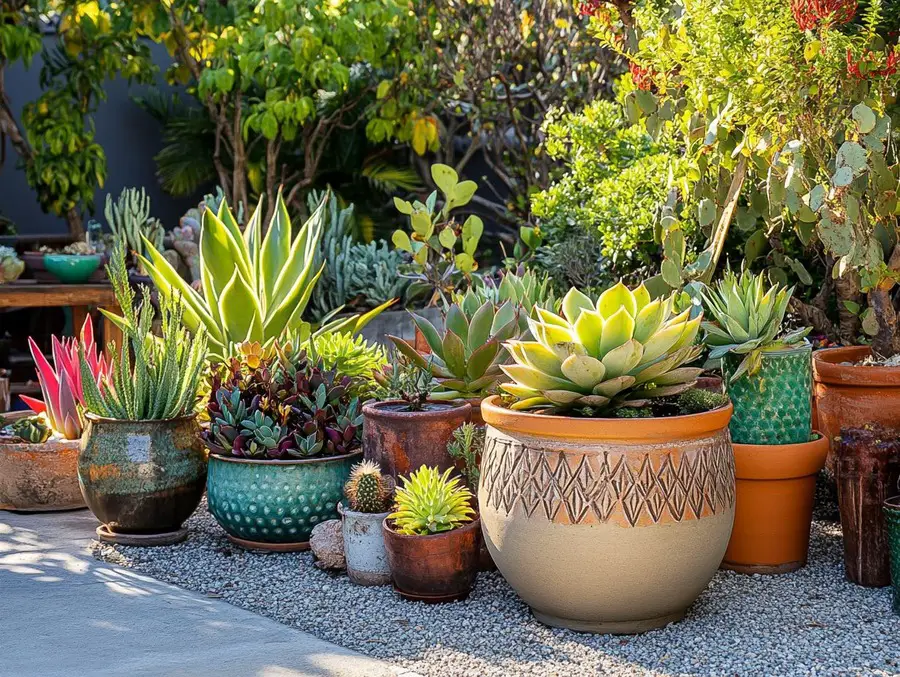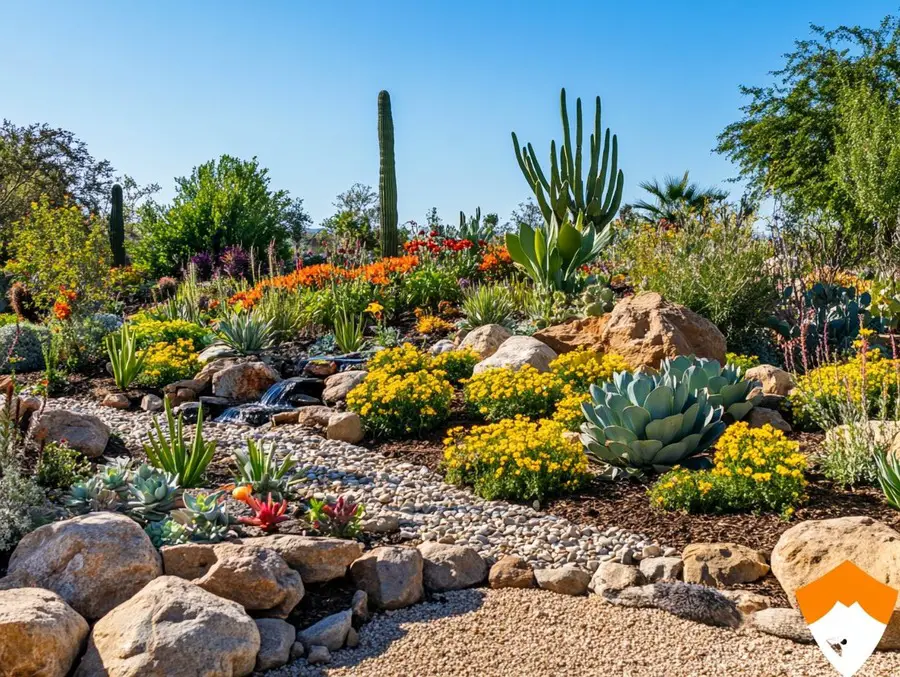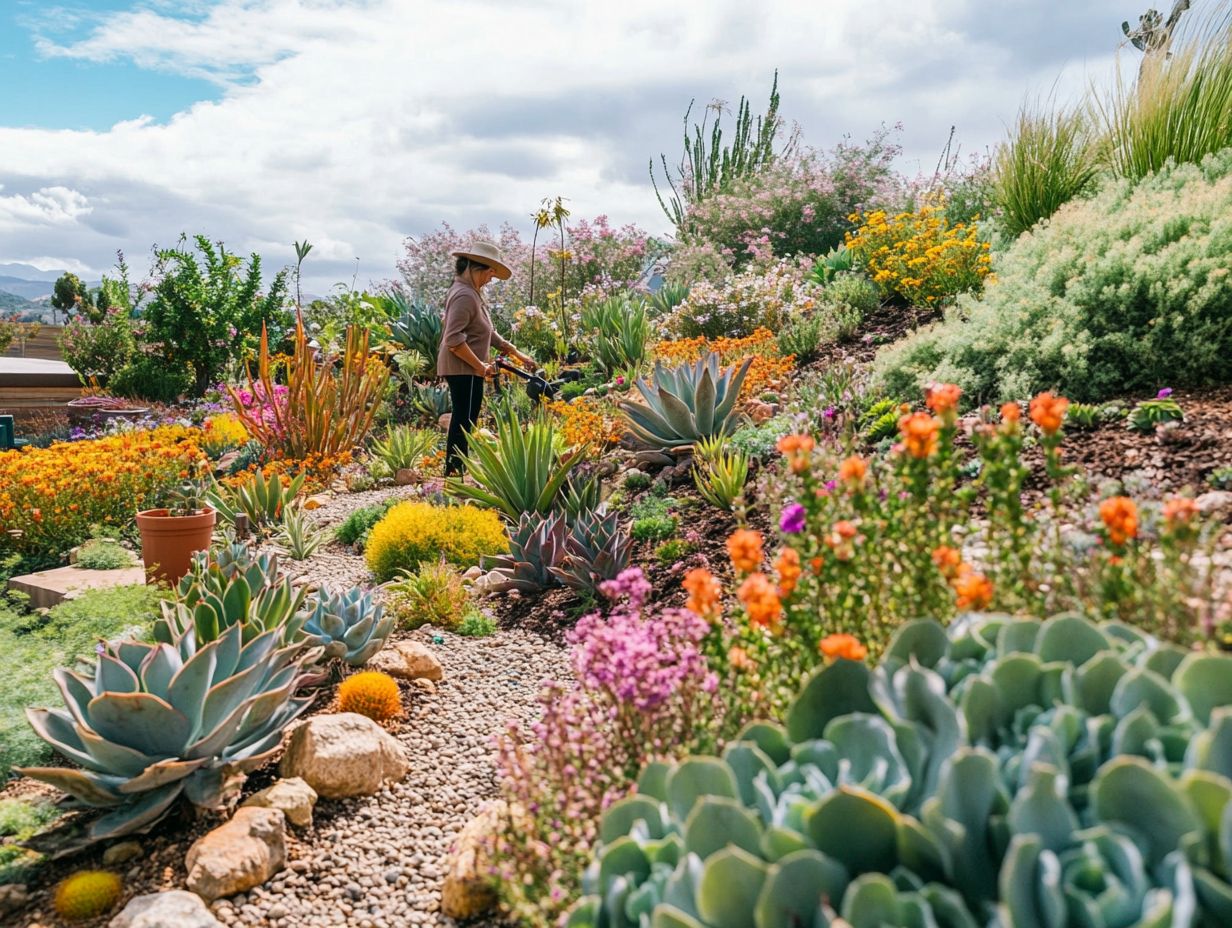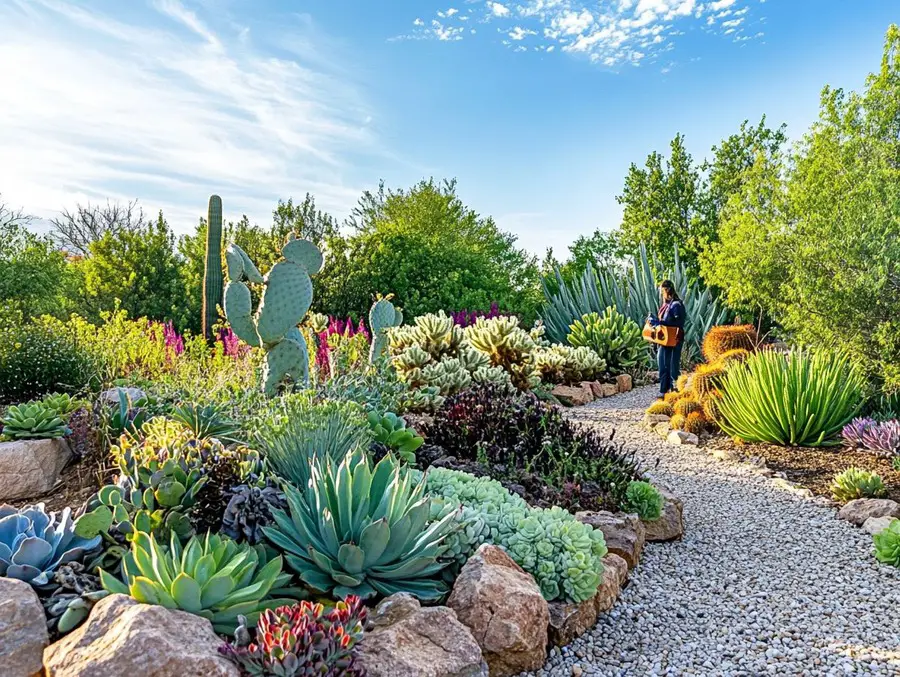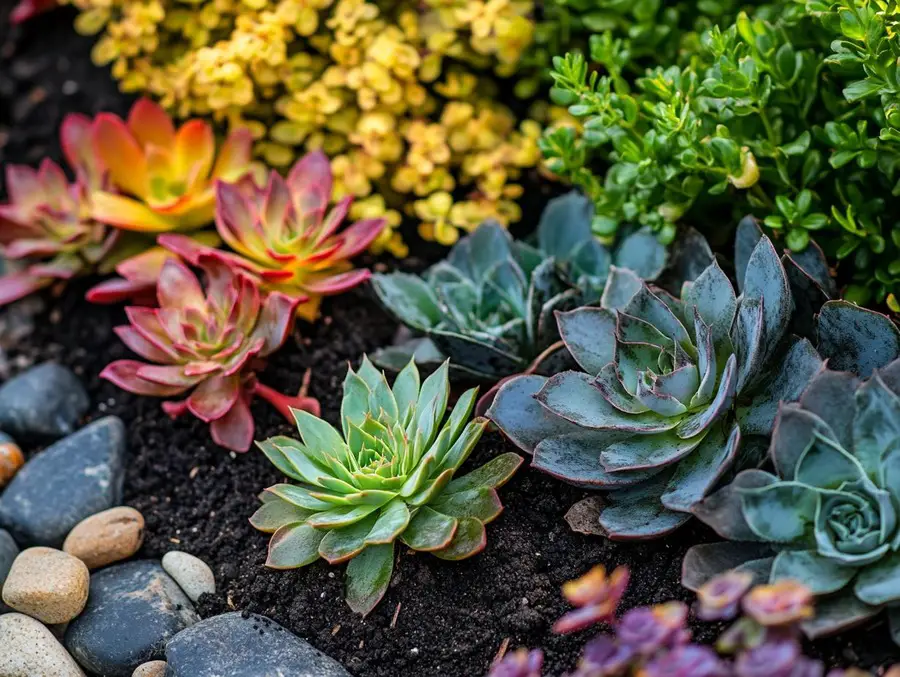We use affiliate links. If you purchase something using one of these links, we may receive compensation or commission.
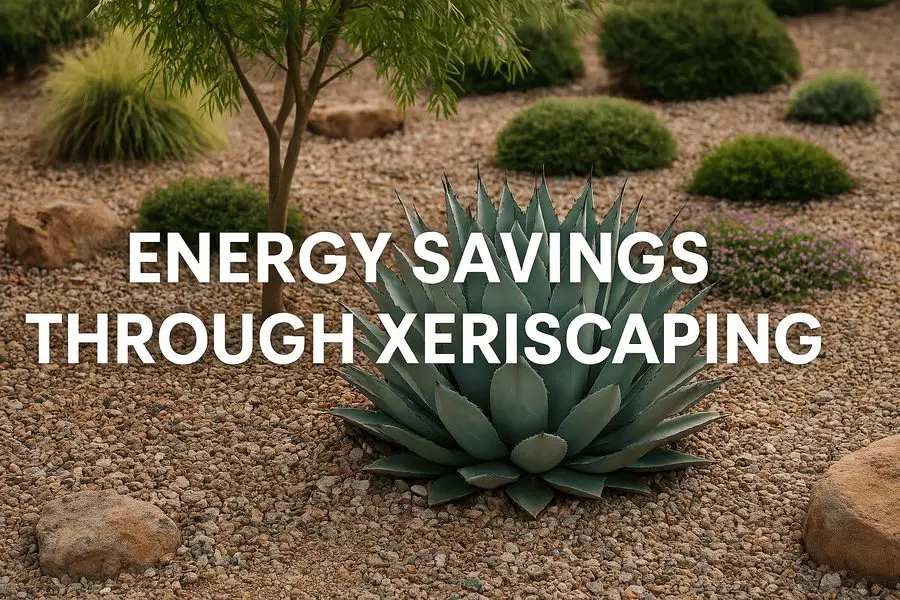
Energy Savings through Xeriscaping isn’t just a perk—it’s a game changer.
If your yard is sucking up resources and running up bills, you’re not alone.
By switching to a smart, low-water landscape, you can cut energy use, stay cooler in summer, and finally let your outdoor space work for you.
Energy Savings through Xeriscaping
Key Takeaways
- Energy Savings through Xeriscaping come from reducing water use, eliminating gas-powered tools, and using plants to cool your home naturally.
- Replacing lawns with drought-tolerant plants and adding strategic shade lowers utility bills, reduces emissions, and boosts comfort.
- It’s a sustainable way to make your landscape energy-smart.
Energy Savings Through Xeriscaping: How Water-Wise Landscaping Cuts Costs
Discover how xeriscaping helps reduce energy bills and water use while keeping your landscape beautiful and low-maintenance year-round.
What Is Xeriscaping and Why It Matters
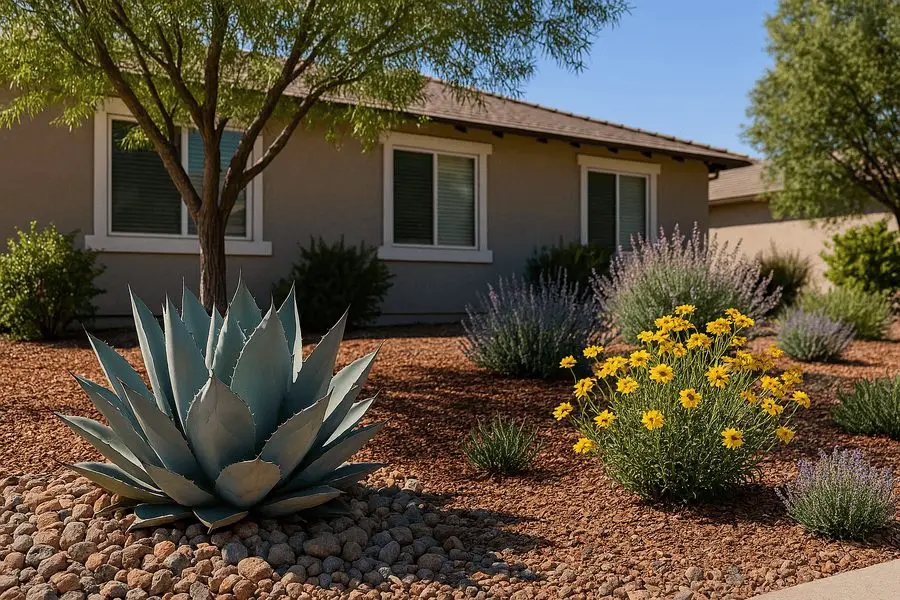
Keeping your energy bills low during a blazing hot summer isn’t easy.
But if your yard is working against your home, not with it, you’re probably paying more than you need to.
Xeriscaping gives you a smart way to cut cooling costs, reduce outdoor maintenance, and save energy—all while looking great.
Want a yard that saves water and cuts your energy bills? That’s where xeriscaping comes in.
It’s all about working with nature, not against it—and keeping things simple, efficient, and beautiful.
🌿 Xeriscaping is a smart landscaping method that:
- Uses drought-tolerant and native plants
- Replaces high-maintenance grass lawns
- Reduces the need for watering and mowing
- Focuses on soil health, mulch, and smart design
Think of it as giving your yard a glow-up that’s both eco-friendly and energy-efficient.
💧 Water and Energy Go Hand in Hand
Saving water doesn’t just help your utility bill—it helps the planet too. And when you use less water, you also use:
- Less electricity for pumping and irrigation systems
- Less gas or power for mowing large grassy areas
- Less effort keeping things alive in hot weather
Plus, with fewer thirsty plants and no sprinkler stress, you’ll actually enjoy your landscape more.
☀️ Perfect for Hot, Dry Climates
If you live in a place like:
- California with its water restrictions
- Arizona where the sun bakes everything
- Colorado where summer storms are unpredictable
- Nevada with dry desert winds
…then xeriscaping is your best friend.
It gives you a landscape that actually thrives in heat and drought—not one that constantly struggles.
Ready to make your yard work for you instead of against you? Xeriscaping is the perfect starting point.
How Xeriscaping Reduces Energy Use
Xeriscaping isn’t just about saving water—it’s also a powerful way to cut down on your overall energy use.
From ditching gas-guzzling yard tools to naturally cooling your home, your landscape can seriously lighten the load on your utility bills.
🌱 Less Lawn, Less Energy
Let’s be real—traditional lawns take a lot of work. And that work burns energy, both yours and the kind that comes from a power outlet or gas tank.
Here’s what you skip when you ditch the grass:
- 🛑 No more weekly mowing with gas-powered lawn mowers
- 🚫 No buzzing weed eaters needed around the edges
- ❌ No blowers blasting debris into your neighbor’s yard
By replacing turf with low-maintenance plants and mulch, you’ll reduce:
- 🛢️ Gasoline use from yard equipment
- ⚡ Electricity demand for irrigation systems
- 💸 Your time and money spent on constant upkeep
🌳 Lower Cooling Costs with Shade and Insulation
Your landscape can do more than look good—it can actually cool down your house.
Here’s how xeriscaping helps beat the heat:
- 🌳 Shade trees placed on the south or west side of your home block harsh afternoon sun
- 🌿 Shrubs near windows keep interior temps lower by insulating against direct light
- 🌾 Groundcovers like creeping thyme help cool the soil and reduce heat reflection off walkways
- 💦 Mulch and moisture in the soil keeps the area around your home cooler thanks to natural evapotranspiration
The result? You run your AC less—and your energy bill shows it.
When you design your landscape with energy savings in mind, every plant pulls its weight.
Plant Choices That Help You Save Energy
Choosing the right plants isn’t just about looks—it’s about turning your yard into a natural energy-saving machine.
With the right setup, your landscape can block heat, cool the soil, and take the pressure off your air conditioner.
🌳 Shade Trees for South and West Sides
Want to cool your home without cranking up the AC? Planting shade trees on the right side of your house makes a huge difference—especially during those scorching summer afternoons.
Here’s what works best in hot, dry climates:
- 🌿 Desert Willow – Fast-growing with gorgeous blooms
- 🌵 Palo Verde – Hardy, native, and full of personality
- 🌳 Mesquite – Great canopy and easy to care for
Smart placement tips:
- 🌞 Plant on the south and west sides of your home to block the strongest sunlight
- 🪟 Keep trees far enough from the house to avoid root issues but close enough to cast shade on windows and roofs
- 📏 Use tall varieties for maximum coverage over patios, walls, and AC units
These trees do double duty—cooling your home and adding beauty to your yard.
🌱 Reflective or Heat-Tolerant Ground Covers
Your ground cover matters more than you think. Some surfaces, like concrete or bare soil, absorb and reflect heat like a mirror.
But certain plants and materials help cool things down.
Try these options:
- 🌸 Creeping thyme – Fragrant, colorful, and stays low to the ground
- 🪨 Dymondia – Silvery leaves reflect light and stay cool
- 🪵 Gravel mulch – Doesn’t trap heat like concrete and helps retain soil moisture
Benefits include:
- 🌡️ Cooler soil temperatures around your home
- ☀️ Less radiant heat bouncing off hardscapes
- 💧 Better water retention with less evaporation
These simple plant choices can have a big impact—keeping your home and garden cooler without lifting a finger.
Efficient Irrigation = Less Pumping Power
It’s no secret—watering your yard can guzzle more energy than you’d think.
But when you switch to smarter irrigation methods, you save on both water and electricity.
That’s a win-win for your wallet and the planet.
💧 Drip Irrigation vs. Sprinklers
Old-school sprinklers are wasteful. They overspray, evaporate fast, and soak areas that don’t even need water.
That means wasted water and wasted energy—especially if you’re using a pump.
Why drip irrigation is the better choice:
- 🎯 Targets the roots directly, where plants need it
- 💦 Reduces evaporation and runoff
- ⚙️ Uses lower pressure, which means your pump works less and uses less electricity
Sprinklers can lose up to 50% of water to evaporation in hot climates. Drip systems? They’re quiet, precise, and super efficient.
⏲️ Timers and Smart Systems
Take the guesswork out of watering by adding a smart timer. These systems do more than just turn on the water—they help you use less of it.
Smart irrigation perks:
- 📅 Set it and forget it with programmable schedules
- ☁️ Weather-based controls skip watering on rainy days
- 🌙 Night watering reduces evaporation and uses off-peak energy
Pair a drip system with a smart controller, and you’ll be watering just enough—and never too much.
When your irrigation system is efficient, your whole yard runs smoother. Want to move on to natural rainwater collection next?
Designing for Natural Rainwater Collection
Why let precious rainwater run down the street when you can put it to work in your yard? Xeriscaping pairs perfectly with simple rain-harvesting techniques that help you conserve even more water—and use way less energy.
🌧️ Swales and Berms for Water Absorption
Swales and berms sound fancy, but they’re really just clever shapes in your landscape that guide rainwater where you want it to go.
Swales are shallow, trench-like dips that catch and hold water.
Berms are little mounds that help redirect flow and slow it down.
Here’s how they help:
- 🚫 Prevent runoff and soil erosion
- 💧 Allow water to soak in slowly, deep into the roots
- 🌿 Support deep-rooted native plants without extra irrigation
You don’t need a big slope or complex tools—just a rake, a shovel, and a little planning.
🛢️ Using Rain Barrels to Store Water
Rain barrels are an easy way to capture roof runoff during a storm and save it for drier days. All you need is a downspout and a barrel with a spigot.
Rain barrel benefits:
- 💰 Free water for your plants
- 💦 Less reliance on municipal water supplies
- ⚡ Reduced pumping and treatment energy on your utility’s end
Hook it up to your drip system or use it for hand-watering your garden beds. It’s like having a mini water tank, just waiting to help you out.
Rainwater collection keeps your garden green without touching the hose—and it’s surprisingly easy to set up.
Long-Term Cost Savings
Switching to xeriscaping isn’t just a feel-good move for the planet—it’s a smart, long-term investment that pays you back year after year.
Once it’s set up, your yard works harder for less money, less effort, and less energy.
💵 Reduced Monthly Utility Bills
One of the first things you’ll notice? Your water and energy bills start shrinking.
Here’s where you’ll save:
- 💧 Lower water bills thanks to drought-tolerant plants and drip irrigation
- ⚡ Reduced electricity use from fewer sprinkler pumps and cooling demands
- 🛢️ Less gas for mowing, edging, and blowing
You’re not just cutting back—you’re cutting out entire tasks and tools.
🔁 Minimal Maintenance = Ongoing Savings
Traditional lawns are a time and money drain. Xeriscaping slashes both.
- 🧹 No weekly mowing
- 🌿 Fewer weeds thanks to mulch and hardy plants
- 🪚 No pruning panic—many native plants naturally stay compact
Once your xeriscape is established, it practically runs on autopilot.
📈 Return on Investment in 1–3 Years
Depending on your setup, the upfront cost of xeriscaping pays for itself fast.
- 🛠️ DIY projects can cost very little
- 💰 Even professional installs usually break even in a few years
- 🏡 Xeriscaped homes often have higher curb appeal and resale value
You’ll save money, reduce stress, and boost your home’s efficiency—all from the ground up.
Tips for Maximizing Energy Savings
Want to get the most out of your xeriscape? A few strategic choices can stretch your energy savings even further.
These little tweaks make a big impact—especially when you’re battling heat waves or high utility costs.
🍂 Use Deciduous Trees for Seasonal Shade
Deciduous trees give you the best of both worlds—shade in summer and sunlight in winter.
Why they work:
- 🌳 In summer, their full leaves block the hot sun
- ❄️ In winter, the bare branches let sunshine warm your home
- 🧊 This natural rhythm helps regulate indoor temps year-round
Best places to plant them:
- South and southwest sides of your house
- Near large windows or patio doors
- Along fences or property lines to cast wide shade
🌾 Mulch Around Your Foundation
Mulch isn’t just for flower beds—it’s a secret weapon for energy savings.
Benefits of mulching near your home:
- 🌡️ Regulates soil temperatures to prevent overheating near your foundation
- 💧 Reduces evaporation and keeps soil moist (which helps cool nearby air)
- 🌿 Blocks weeds and protects shallow plant roots from heat stress
Go for natural mulch like bark chips, pine straw, or shredded leaves for the best results.
🚫 Avoid Heat Traps Near AC Units or South Walls
Not all plants are energy-savers—some can actually trap heat and make things worse.
What to avoid:
- Dense shrubs too close to south-facing walls
- Large rocks or dark mulch that reflect or store heat
- Planting too close to air conditioners, which need airflow to work efficiently
Do this instead:
- 🌬️ Keep at least 2–3 feet of open space around your AC unit
- 🌿 Use low-growing groundcovers or reflective plants in heat-prone spots
- ☀️ Choose light-colored mulch near walls to reduce radiant heat
With just a little planning, your landscape can become a built-in cooling system.
Real-World Examples of Energy-Saving Xeriscapes
Xeriscaping isn’t just a theory—it’s working right now in some of the hottest, driest cities in the U.S.
From desert suburbs to bustling urban yards, people are cutting energy use, slashing utility bills, and creating landscapes that thrive in the heat.
🏜️ Las Vegas, NV: A City-Wide Shift to Save Energy
Las Vegas went all-in on xeriscaping, and the results speak for themselves.
Here’s what they did:
- 🚫 Banned non-functional turf in new developments
- 💧 Replaced over 200 million square feet of grass
- 💡 Reduced outdoor water and energy use across thousands of homes
Locals are now saving money on their energy bills—not just from less watering, but from cooler homes thanks to smart shade and plant placement.
🌵 Tucson, AZ: Xeriscaping Meets Urban Cooling
In Tucson, residents face long, hot summers and limited water. Xeriscaping is helping them beat both.
What’s working in Tucson:
- 🌳 Native trees placed to shade roofs and block afternoon sun
- 💦 Rainwater harvesting paired with low-water plants
- 💸 Homeowners save on cooling and qualify for city rebates
Tucson Water even offers a “Landscape Rebate Program” for residents who switch to low-water designs. That’s cash in your pocket just for using less!
💰 Utility Rebates and Incentives in Dry States
Many states and cities are offering real money to homeowners who make the switch.
Look for programs like:
- Cash for Grass – Rebates for removing traditional lawns
- Drip irrigation upgrades – Rebates for converting old sprinklers
- Rainwater harvesting incentives – Discounts on barrels and tanks
- Shade tree programs – Free or low-cost trees to reduce AC use
Where to check:
- Your local water utility or energy provider
- City or county conservation departments
- State-level environmental or energy programs
These real-life examples prove that xeriscaping isn’t just good for the environment—it’s good for your wallet, too.
Energy Savings through Xeriscaping Conclusion
Your Landscape, Your Power Saver
Xeriscaping does more than make your yard look great—it turns it into a quiet, hardworking energy-saving system.
By replacing thirsty lawns with drought-tolerant plants, using smart irrigation, and planting for shade and airflow, you’re cutting back on electricity, water, and maintenance.
🌿 No more gas-powered mowers.
☀️ Less strain on your AC.
💧 Way less water waste.
Xeriscaping Reduces Energy Usage
Key Takeaways
- Xeriscaping reduces energy usage by minimizing the need for watering, mowing, and air conditioning.
- Strategic plant placement shades your home, lowers cooling costs, and cuts utility bills.
- This sustainable landscaping method helps conserve resources while creating a beautiful, low-maintenance yard that thrives in hot, dry climates.
When you rethink your outdoor space as part of your home’s overall efficiency, every tree, shrub, and patch of mulch pulls double duty.
You get a yard that’s not only sustainable but also saves you money and keeps your home more comfortable year-round.
So if your current landscape is more energy-drain than energy-smart—it’s time for a change.
With xeriscaping, your garden works for you. Ready to make the switch?
Benefits of Xeriscaping: Save Water, Time, and Money
Learn More:
Want to start saving money and energy through smart landscaping? Explore our list of drought-tolerant plants or check out our step-by-step xeriscaping guide to get started.
Best Plants for Xeriscape Gardens: Hardy & Beautiful
Xeriscape Garden Styles: Easy Low-Maintenance Options
Xeriscape Gardening Techniques: Easy Low-Water Tips
Xeriscape Garden Design & Layout: Easy Water-Wise Beauty
Saving Energy with Xeriscaping FAQs
Q: Can xeriscaping really lower my utility bills?
A: Yes! By shading your home and reducing watering and mowing needs, xeriscaping helps reduce cooling costs and electricity use.
Q: What plants help block sun and reduce AC use?
A: Native trees like Palo Verde, Mesquite, and Desert Willow provide excellent shade and cooling without needing much water.
Q: Is xeriscaping expensive to install?
A: It can have higher upfront costs, but you’ll save long-term with lower energy, water, and maintenance expenses.
Related Content
Visit my Amazon Influencer Page for videos and gardening products Grow Your Own Garden

